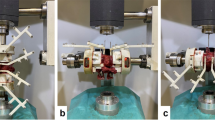Abstract
Purpose
The aim of this study was to quantify the stabilizing effect of the passive structures in thoracic spinal motion segments by stepwise resections. These data can be used to calibrate finite element models of the thoracic spine, which are needed to explore novel surgical treatments of spinal deformities, fractures, and tumours.
Method
Six human thoracic spinal motion segments from three segmental levels (T2–T3, T6–T7, and T10–T11) were loaded with pure moments of 1 and 2.5 Nm in flexion/extension, lateral bending, and axial rotation. After each loading step, the ligaments, facet capsules, and the nucleus pulposus were stepwise resected from posterior to anterior direction, while the segmental relative motions were measured using an optical motion tracking system.
Results
Significant increases (p < 0.05) in the range of motion were detected after resecting the anterior spinal structures depending on loading magnitude, motion direction, and segmental level. The highest relative increases in the range of motion were observed after nucleotomy in all motion directions. The vertebral arch mostly stabilized the thoracic spinal motion segments in flexion and extension, while the facet joint capsules mainly affected the segmental stability in axial rotation. Coupled motions were not observed.
Conclusions
The anulus fibrosus defines the motion characteristics qualitatively, while the ligaments and the presence of the nucleus pulposus restrict the mobility of a thoracic spinal motion segment solely in a quantitative manner. The posterior ligaments do not predominantly serve for primary stability but for the prevention of hyperflexion.
Graphic abstract
These slides can be retrieved under Electronic Supplementary Material.






Similar content being viewed by others
References
Schmidt H, Heuer F, Drumm J, Klezl Z, Claes L, Wilke HJ (2007) Application of a calibration method provides more realistic results for a finite element model of a lumbar spinal segment. Clin Biomech 22(4):377–384
Heuer F, Schmidt H, Klezl Z, Claes L, Wilke HJ (2007) Stepwise reduction of functional spinal structures increase range of motion and change lordosis angle. J Biomech 40(2):271–280
Panjabi MM, Hausfeld JN, White AA (1981) A biomechanical study of the ligamentous stability of the thoracic spine in man. Acta Orthop Scand 52(3):315–326
Oda I, Abumi K, Cunningham BW, Kaneda K, McAfee PC (2002) An in vitro human cadaveric study investigating the biomechanical properties of the thoracic spine. Spine 27(3):E64–E70
Anderson AL, McIff TE, Asher MA, Burton DC, Glattes RC (2009) The effect of posterior thoracic spine anatomical structures on motion segment flexion stiffness. Spine 34(5):441–446
White AA 3rd, Hirsch C (1971) The significance of the vertebral posterior elements in the mechanics of the thoracic spine. Clin Orthop Relat Res 81:2–14
Watkins R 4th, Watkins R 3rd, Williams L, Ahlbrand S, Garcia R, Karamanian A, Sharp L, Vo C, Hedman T (2005) Stability provided by the sternum and rib cage in the thoracic spine. Spine 30(11):1283–1286
Brasiliense LB, Lazaro BC, Reyes PM, Dogan S, Theodore N, Crawford NR (2011) Biomechanical contribution of the rib cage to thoracic stability. Spine 36(26):E1686–E1693
Liebsch C, Graf N, Appelt K, Wilke HJ (2017) The rib cage stabilizes the human thoracic spine: An in vitro study using stepwise reduction of rib cage structures. PLOS One 12(6):e0178733
Wilke HJ, Wenger K, Claes L (1998) Testing criteria for spinal implants: recommendations for the standardization of in vitro stability testing of spinal implants. Eur Spine J 7(2):148–154
Wilke HJ, Jungkunz B, Wenger K, Claes LE (1998) Spinal segment range of motion as a function of in vitro test conditions: effects of exposure period, accumulated cycles, angular-deformation rate, and moisture condition. Anat Rec 251(1):15–19
Adams MA, Dolan P, Hutton WC (1988) The lumbar spine in backward bending. Spine 13(9):1019–1026
Wilke HJ, Claes L, Schmitt H, Wolf S (1994) A universal spine tester for in vitro experiments with muscle force simulation. Eur Spine J 3(2):91–97
Borkowski SL, Tamrazian E, Bowen RE, Scaduto AA, Ebramzadeh E, Sangiorgio SN (2016) Challenging the conventional standard for thoracic spine range of motion: a systematic review. JBJS Rev 4(4):e51–e511
Wilke HJ, Herkommer A, Werner K, Liebsch C (2017) In vitro analysis of the segmental flexibility of the thoracic spine. PLOS One 12(5):e0177823
Liebsch C, Graf N, Wilke HJ (2017) EUROSPINE, 2016 FULL PAPER AWARD: wire cerclage can restore the stability of the thoracic spine after median sternotomy: an in vitro study with entire rib cage specimens. Eur Spine J 26(5):1401–1407
Kettler A, Wilke HJ, Haid C, Claes L (2000) Effects of specimen length on the monosegmental motion behavior of the lumbar spine. Spine 25(5):543–550
Liebsch C, Graf N, Wilke HJ (2018) The effect of follower load on the intersegmental coupled motion characteristics of the human thoracic spine: an in vitro study using entire rib cage specimens. J Biomech 78:36–44
Healy AT, Mageswaran P, Lubelski D, Rosenbaum BP, Matheus V, Benzel EC, Mroz TE (2015) Thoracic range of motion, stability, and correlation to imaging-determined degeneration. J Neurosurg Spine 23(2):170–177
Wollowick AL, Farrelly EE, Meyers K, Grossman S, Amaral TD, Wright T, Sarwahi V (2013) Anterior release generates more thoracic rotation than posterior osteotomy: a biomechanical study of human cadaver spines. Spine 38(18):1540–1545
Myklebust JB, Pintar F, Yoganandan N, Cusick JF, Maiman D, Myers TJ, Sances A Jr (1988) Tensile strength of spinal ligaments. Spine 13(5):526–531
Acknowledgements
This study was funded by the German Research Foundation (DFG, Projects WI 1352/20-2 and WI 1352/23-1). The authors also gratefully acknowledge David Volkheimer for their assistance.
Author information
Authors and Affiliations
Corresponding author
Ethics declarations
Conflict of interest
The authors of this study declare that they have no conflict of interest to disclose.
Additional information
Publisher's Note
Springer Nature remains neutral with regard to jurisdictional claims in published maps and institutional affiliations.
Electronic supplementary material
Below is the link to the electronic supplementary material.
Rights and permissions
About this article
Cite this article
Wilke, HJ., Grundler, S., Ottardi, C. et al. In vitro analysis of thoracic spinal motion segment flexibility during stepwise reduction of all functional structures. Eur Spine J 29, 179–185 (2020). https://doi.org/10.1007/s00586-019-06196-7
Received:
Revised:
Accepted:
Published:
Issue Date:
DOI: https://doi.org/10.1007/s00586-019-06196-7




